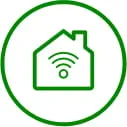Fiber internet isn't just about streaming faster. It's about resilience, safety and equity.
In Darrington, Washington, Fire Station 38 once relied on what the crew called a "glorified hotspot." Chief Joel Johnson described Zoom calls that only worked "on a good day." For years, this rural community managed with unreliable internet service that affected everything from emergency coordination to local businesses.
Now, thanks to new fiber infrastructure, Darrington's story is changing. When fast, reliable connectivity comes to a rural community, it doesn't just make the internet faster. It strengthens the local economy, supports first responders and builds the infrastructure that keeps people safe.
When connection determines safety
Before, daily life in Darrington often depended on luck. First responders had to work around weak signals and outdated lines. A pharmacy closure forced residents to use the library's WiFi to order essential medications.
These gaps represent more than inconvenience. Across rural America, limited internet affects healthcare, education, small-business operations and even dispatch reliability during emergencies. Communities like Darrington were living proof of how the digital divide impacts both safety and opportunity.
The SR 530 Broadband Project: bridging the divide
The SR 530 Broadband Project brought together public and private partners with a shared goal: connect the unconnected. Funded through a $17 million federal grant, the project united the Washington State Broadband Office, Snohomish County Council, Ziply Fiber, Sno-Isle Libraries and other regional leaders.

Together, we built a network designed to reach community anchor institutions such as fire stations, libraries and medical centers. This wasn't just an investment in faster internet. It was an investment in Darrington's long-term strength.
Opening doors to local growth
With faster, symmetrical speeds, Reliable fiber internet opens doors to economic growth. residents can launch online businesses, telecommute or take classes from home. Libraries evolve into digital learning hubs, and small businesses can finally operate modern systems without interruption.
Fiber internet enables everything from video calls to cloud-based point-of-sale systems, helping entrepreneurs stay competitive. With scalable speed tiers ranging from 100 Mbps up to 50 Gbps, Ziply Fiber's network supports future innovation and sustainable local development.
What was once a challenge of distance is becoming a story of opportunity.
Powering first responders when seconds matter
For first responders, seconds matter. Reliable fiber connectivity strengthens coordination between dispatch centers and satellite stations, reducing dependence on fragile cell towers and aging analog lines.
With fiber internet, communication during emergencies becomes faster and clearer. Data for 911 systems, wildfire tracking and mapping can move instantly between teams. As one local leader put it, "It's about saving seconds and saving lives."
Better connectivity doesn't just help response times. It helps responders stay connected to one another and to the people they serve.
A stronger, more connected community
When fiber internet expands, communities transform. Darrington's library, once a WiFi lifeline during the 2014 mudslide and again during the pandemic, now connects residents to remote work, telehealth and education. Students can participate in virtual classrooms. Seniors can consult with doctors without traveling long distances.
"I want to thank Snohomish County, the State Broadband Office, and Ziply Fiber for launching this project. We know digital access is critical for our communities to thrive, and our library staff are dedicated to digital inclusion and empowerment."—Lois Langer Thompson, executive director of Sno-Isle Libraries.
At the recent groundbreaking, local pride was easy to see. Residents, local officials and partners gathered not just to celebrate faster internet speeds but to celebrate what they represent: progress, access and resilience.
Investing in the future of rural connectivity
The SR 530 Broadband Project is just one example of how Ziply Fiber is helping shape the future of rural connectivity. We're building a network designed for the next generation of communication, commerce and community.
From Highway 530 to the rest of Ziply Fiber's footprint, our mission remains the same. We're investing in long-term infrastructure that brings safety, opportunity and equity to places once left behind.
Fiber internet isn't just faster. It's transformative.






